By Sandy Kinghorn
The Keren – Part Two
We played our part in various military exercises but most voyages were straight trooping runs and I found the little North Sea ferry took to the mighty South Atlantic rollers like a seagull. Her stabilisers helped to keep mal de mer at bay and despite having at any one time over 500 passengers and 80 crew aboard, she never seemed overcrowded. She also carried a permanent military staff with an army major as hip’s Commandant in charge. Fortunately he and I hit it off rather well. A North Sea overnight ferry’s facilities are, however, limited, as of course some passengers pointed out. “No swimming pool? Uganda has a lovely swimming pool!” But at least our lot were housed decently in cabins. “Uganda has dormitories from her former schoolship days”. Nine days at sea were no real hardship to anyone, and army commanders, especially, relished this rare chance of travelling by sea with their men. Getting to know and like our armed forces (most of ’em) was a great experience and they in their turn seemed glad to be meeting their Merchant Navy, “at home”, so to speak.
The armed forces of the crown are adept at providing entertainment, usually with a delightfully self-mocking slant, and many concerts were put on for us (at my suggestion) by them to an enthusiastic audience. The Royal Navy Fleet Air Arm even treated us to a Floral Dance, as put on each year at Helston, Cornwall, near their Culdrose base. Brave men in top hats and frock coats (outdated ship’s charts, paint and the ragbag came in useful here) danced gracefully with fair maidens dressed ravishingly in haute couture and gumboots. All these ‘damsels’ had enormous bosoms and many sported beards. After dancing to ‘that tune’, the Floral Dance, all through the ship, the way was led to ‘C’ Car Deck, transformed into a fairground with hoopla, coconut shies, ‘Penguin’ racing, cake-weight guessing, etc etc, an effort which pulled in over £400 for charity. There was deck hockey, and darts, tugs of war and rifle shooting. When the Commandant worried that his troops’ rifle practice would disturb the watch below’s sleep, we decided the best way round this problem was to invite the crew to participate, an offer taken up gladly. Targets from the ship’s stern were kites and balloons, boxes of rubbish and empty beer cans. The rattle of gunfire and reek of cordite intoxicating, and some of our best shots turned out to be young stewards who didn’t know they had it in them. A mock man-overboard one morning had all hands in a high state of trepidation as only a select few knew it was only an exercise. The ship was turned in the classic Williamson manner and a great shout went up when, an hour later, our ‘man’ was spotted right ahead. That he was only a dummy dressed in red did not, by this time, seem to matter.
In heavy weather passengers were escorted in small parties to the bridge to watch open-mouthed from the wheelhouse the whole wild panorama of the South Atlantic in majestic mood, from ringside seats. Almost miraculously the storm abated in time for the ship’s Remembrance Day Service on Sunday, 11th November, a most moving ceremony on the afterdeck attended by over 600 troops, civilians and crew members. As our wreaths were cast on the still quite stormy waters, the sun came out and a lone bugler, high on the flight deck, played the Last Post, followed, after a brief pause, by Reveille. Like the Lord’s Prayer, this seemed to us to say it all, as two albatrosses wheeled in our wake.
Back in Stanley we occasionally helped local pensioners with such little tasks as gardening, a delightful break from sea life. Thus, one afternoon I was happily pulling up weeds from a flower bed and tossing them into the dustbin with, it must be admitted, a fair amount of soil attached. Bringing me my cup of tea my hostess observed, rather sharply, “It has taken us 150 years to get decent soil onto this gigantic peat bog”, by which she meant the Falklands, “Please don’t just throw it in the dustbin!”
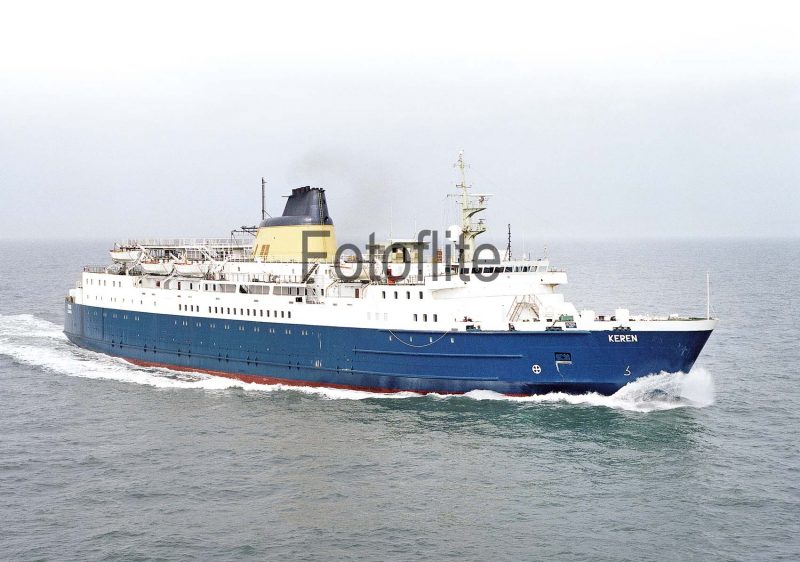
At Ascension Island there is no port, ships lay off at anchor when weather permitting while passengers came and went by helicopter. There was an alternative by small launch, the Gannet, which would angle itself alongside the stone wall from which dangled a rope secured to an overhead beam. All you had to do was catch the rope as the boat rolled towards it and swing ashore to the concrete steps Tarzan style. It made a change from helicopters!
Long the base of the Cable and Wireless Company, Ascension is the centre of a huge web of undersea cables. Many of these are still in use, many more are not, being old and disused, and it is no uncommon event for a ship to hook one up on her anchor when the time comes to depart. On such occasions the practice is to pass a soft manila rope round the hooked cable. A man goes over the bow on a bosun’s chair to do this and hang it off, then lower the anchor. With a bit of luck the cable comes clear first time, but it is often a longish job especially if a high swell is running.
Ascension is a fascinating clump of rugged rock in the South Atlantic almost midway between Brazil and West Africa, an old volcanic heap of brown clinker first discovered by the Portuguese navigator Joao de Nova Gellego on 20th May 1501, which happened to be Ascension Day that year. The British established a garrison of Royal Marines there in 1821 when it was feared the French were about to mount an escape bid from Ascension to spring Napoleon Bonaparte out of St. Helena where he was imprisoned after meeting his Waterloo in 1815. The marines remained until 1922 by which time the threat had passed, building Georgetown with its church and barrack square, its houses and, interestingly, its concrete rain catchments up Green Mountain where the drizzly damp climate makes a pleasant oasis above the parched brown rocks.
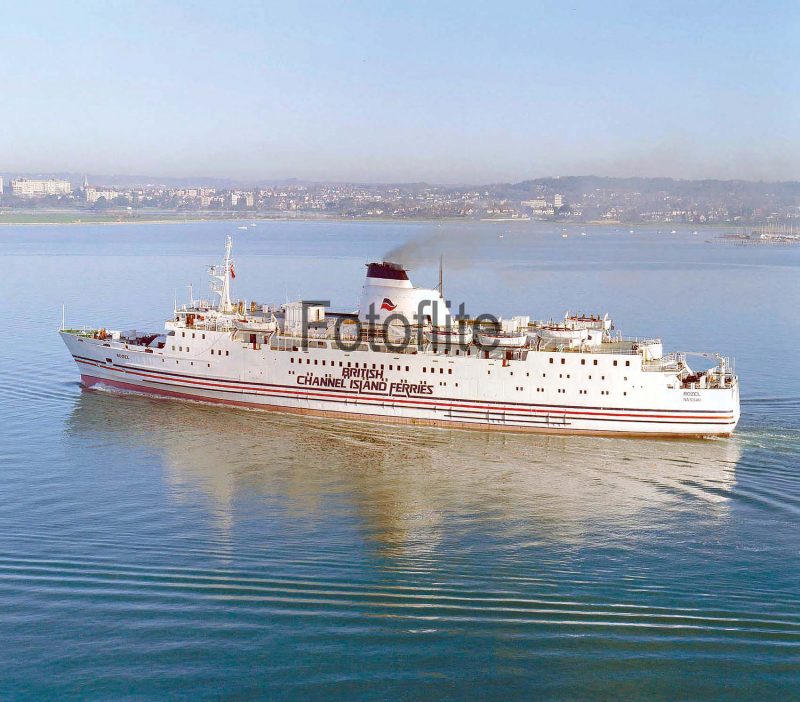
In Georgetown are still many relics of the old sailing navy rope walks, rigging lofts and turtle ponds concreted to hold water, for turtles are yet another of Ascension’s delights and mysteries. Why would a turtle want to swim 1,200 miles from the coast of Brazil just to lay its eggs on Ascension? One fine morning, going ashore in our Gemini rubber dinghy we were astonished when a large turtle surfaced alongside, regarding us curiously as though our low, black rubber boat were some new kind of turtle.Wideawake airport, named after the Wideawake Tern which nests here in large colonies called ‘Fairs’, became one of the busiest for a few days in 1982, coping with traffic of an almost exclusively military nature. Another spot well worth seeing, even if it only fills one with pity, is the Bonetta Cemetery, a tiny twenty-grave plot in this most inhospitable cinder-like terrain where lie the mortal remains of those who died of fever a century and more ago. When a ship put in with yellow fever, usually from West Africa, the sufferers were appointed desolate habitation at the aptly named Comfortless Cove, one mile from Georgetown. Food was left at an appointed spot, the carrier then firing a rifle shot as dinner gong, rapidly retiring before he, too, became a victim. Even those who recovered were not allowed back in town but eked out the remainder of their days caring for the sick. There are several such cemeteries on Ascension Island but Bonetta is the best preserved.
So, having disentangled our anchor from the seabed’s debris we headed south again for the Falklands. Uganda was somewhat slower than Keren and as the speed of a joint service, like the speed of a convoy, is governed by the speed of the slowest ship, Keren usually had a day or two in hand each voyage which enabled us to slow down and save fuel. It could be that I was directed, first, to San Carlos Water, just a hundred miles by sea from Stanley, at the north western corner of East Falkland, which was where the returning British first landed, fortunately while the Argentine sentries were asleep. We would go alongside an anchored tanker to take fuel (still called ‘bunkers’ long after the days of coal) in the now-silent inlet, so like the English Lake District. Hard to realise that only three years ago this was ‘Bomb Alley’ through which screamed Argentine aircraft with their deadly loads, or that that old derelict frigorifico over there in Ajax Bay was Surgeon Commander folly’s hospital, his Red and Green Life Machine where every man, British and Argentine, who came in injured but alive went out alive, no mean feat under the attack conditions prevailing at the time.
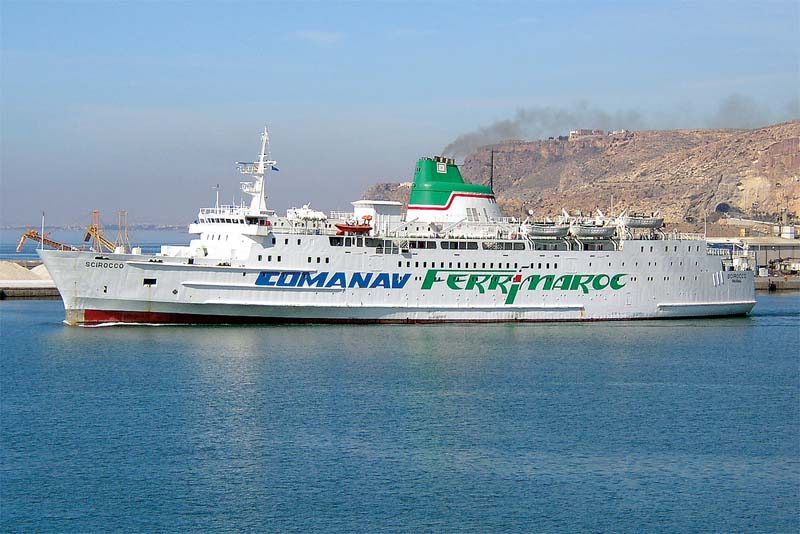
Our ship anchored near the buoys marking HMS Antelope’s grave. Blue Beach Cemetery was close by, where Colonel H. Jones V.C. and his comrades sleep now in peace, a touchingly beautiful little plot lovingly maintained by the managers of the nearby farm.

Up anchor and down Falklands Sound, then, where fabled wrecks containing hoards of copper ingots lure the brave and hardy to fit-out salvage expeditions back in Stanley, to Fox Bay where Gemini took us to visit the gentoo penguins. Round to Stanley next, that now familiar little town with its neat houses, brightly painted corrugated iron roofs, red-roofed grey stone cathedral, and the neat little white wooden Catholic chapel of St. Mary which I shall never forget seeing in vivid silhouette from the harbour against the flaring glow that dreadful night of 9/10th April 1984 when the hospital caught fire, killing more civilians than had died in the conflict.
But the new Mount Pleasant Airport, a truly remarkable feat of civil engineering, had been opened by Prince Andrew and wide-bodied jet airliners had, at a stroke, rendered yet another troopship redundant. Uganda had retired earlier, the termination of her long and interesting career.
Where next? We lay alongside the FIPASS for a while, providing bed, breakfast and meals for the news reporters out to cover the airport’s opening. Detachments of troops whose airport accommodation was yet to be completed waited with us, Paras and Gurkhas among them, soon to deploy elsewhere. We were Mother Keren to one of our submarines at a buoy in the harbour. The submariners were delighted to savour Keren’s space and comfort for even a modern submarine is cramped by comparison and also to have their washing done and wallow in hot baths with unlimited fresh water.
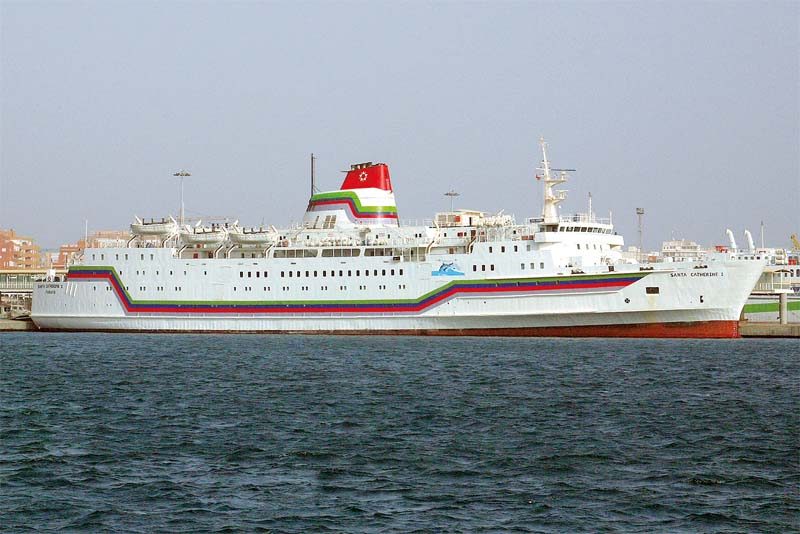
What next? The answer came soon. “You are going to South Georgia!” I should say here that many of us had been wanting to go to South Georgia for the previous three years since we heard there was a chance! In the conflict’s beginnings many ships went there, not least the Queen Elizabeth 2, though because of her size she only anchored on the submerged ridge outside King Edward Cove, in Cumberland Bay. Now Keren was to go right in, alongside the wharf if possible, to deliver much needed stores for the British garrison.
Having borrowed a line-throwing rifle, though not the helicopter requested, Keren sailed from Stanley for the last time, after a ‘lap of honour’ round the harbour attended by many who had helped to make our time in the Falklands so pleasant, including Sir Rex and Lady Mavis Hunt, those two wonderful people who epitomized the Falklands Spirit. Out through The Narrows for the last time, appropriately enough in a blizzard, our passengers were disembarked into the tug Irishman. A Falklands veteran, she it was who went after the smouldering Atlantic Conveyor through fog, eventually following her oil slick until they found her, took her in tow, only to lose her when she sank on passage back to the Falklands.
My first appointment was to go to Bird Island, South Georgia, and take off from the British Antarctic Survey hut, a British scientist who had broken a collar bone. But when we arrived off Bird Island, rags of cloud tore at the snowy mountain peaks and such a southwesterly swell was running into the Sound that launching our boat could have been disastrous. Instead, our doctor was able to speak to the scientists in the hut by radio telephone and find that the fracture had been correctly set and was healing well. So I turned out of Bird Island Sound and headed for Grytviken, in King Edward Cove, off Cumberland Bay. We arrived next daybreak through floating ice in the shape of small bergs which are called “growlers” and “bergy bits”. A few large bergs lit by the morning sunshine were radiant in the distance but I was assured by the garrison commander that the cove had cleared of ice during the night – Splendid! Extra lookouts had been posted all night as we knew, from a talk specially given to us before we sailed from Stanley, that growlers are old, almost transparent ice, carved from glaciers. Awash, they make poor radar targets. Although South Georgia, same latitude south as Carlisle is north, is a little south of the Falklands, it enjoys a temperate climate not unlike that experienced on my own north-east coast of England. The 726 miles on a course of 100 degrees true (East by South) from Stanley take a ship through the Antarctic Convergence Barrier and so, climatically, into the Antarctic. Temperatures plunged below zero, for this was mid winter, June.
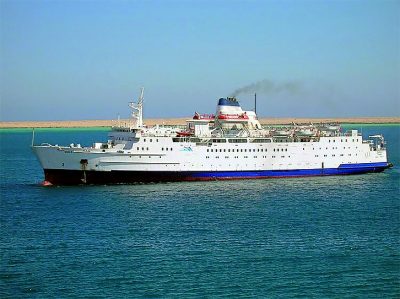
Slowly the vessel entered King Edward Cove with my deck officers checking bearings and position as I conned the way in. There was no pilot here of course. The tiny, almost circular cove is surrounded by 2,000 feet high mountains, snow covered at this time of year. At the far end lies Grytviken (Pot Cove in Norwegian, from the trypots of the early sealers), now a ghost town, complete with white wooden church, ‘kinema’ and the whale factories which flourished, then died in the early ‘sixties when there suddenly became no market for whale products. The whalers left, expecting to return, but never did. Grytviken was, then, like a shore-based Mary Celeste with jobs waiting to be completed, stores waiting to be unpacked. On this strange little scene of man’s folly, the awesome snow clad mountains looked down with immense disdain. Opposite Grytviken, on King Point, stood Discovery House, a green, two-storied red-roofed building housing troops and scientists, with a few scattered buildings and a wooden wharf – looking about the size of a soap box! At this I would now moor Mediterranean style (in the practised manner) and discharge our cargo through the stem door in what we estimated would take a couple of hours, using the ship’s fork trucks. The line-throwing gun was used to get our first line ashore. In pleasant weather our pre-arranged plan went smoothly, too smoothly. No sooner had our stem ramp been lowered onto the tiny jetty than all hell broke loose!
It was as if the elements were outraged that this North Sea Ferry should have the temerity to come here. Katabatic winds of hurricane force screamed at us suddenly from, it seemed, all directions, blowing snow off the mountains in blinding flurries. The stem door was immediately raised and secured and after five further unsuccessful attempts at berthing, Keren clawed her way out into the cove’s centre and re-anchored. My horror at finding I had punched a 21 inch hole aft in the steering flat was only tempered with relief that this gash was above the waterline – just! The soap box had taken a battering, too. As our second engineer welded over the hole and the mate and carpenters applied a cement box for good measure, we meekly worked our cargo out through the stern door, lowered once more, into the ship’s motorboat for ferrying ashore. In this our crew pitched in with a zest that was heartening to see. The cement would take twenty four hours to set hard.
A force 10 blizzard blew all that night but the anchors held, with a little assistance now and then from the engines, and it was almost as though the elements felt we had passed their test, for next day dawned in ethereal calm and beauty which lasted until we sailed the following morning. Everything, ship included, lay under a thick mantle of snow and that night under a full moon every detail of every mountain was mirrored to perfection in the glassy waters of the cove.
When next morning we came to sail, the stem door could not be raised.
Had I damaged that, also, in my grapple with the soap box? Fortunately the chief officer and I together found that ice had formed in the channels and once we had chipped this away the door was able to be raised and secured. Phew! No ship repair facilities existed in South Georgia.
By the time we sailed King Edward Cove had frozen over and seabirds walked and slipped like tipsy sailors on the ice, but our anchors came up without trouble and we moved out, marvelling at the intense turquoise green of the glacier’s edge as we headed north to Ascension and Portsmouth, Homeward Bound!

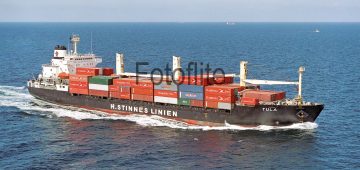


Comments
Sorry, comments are closed for this item